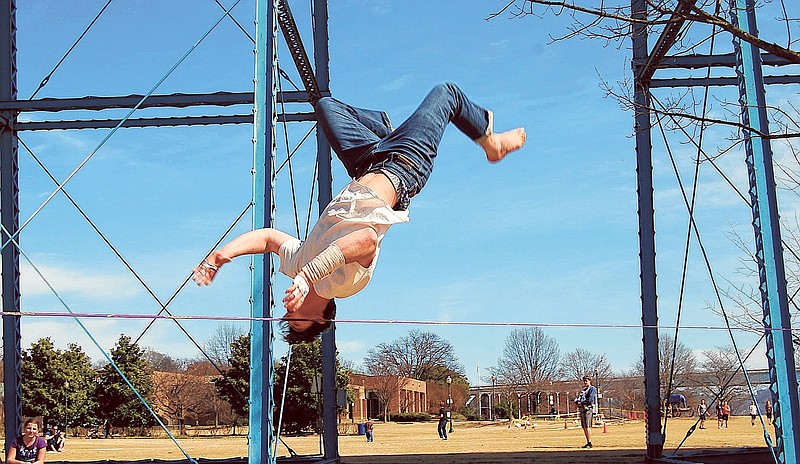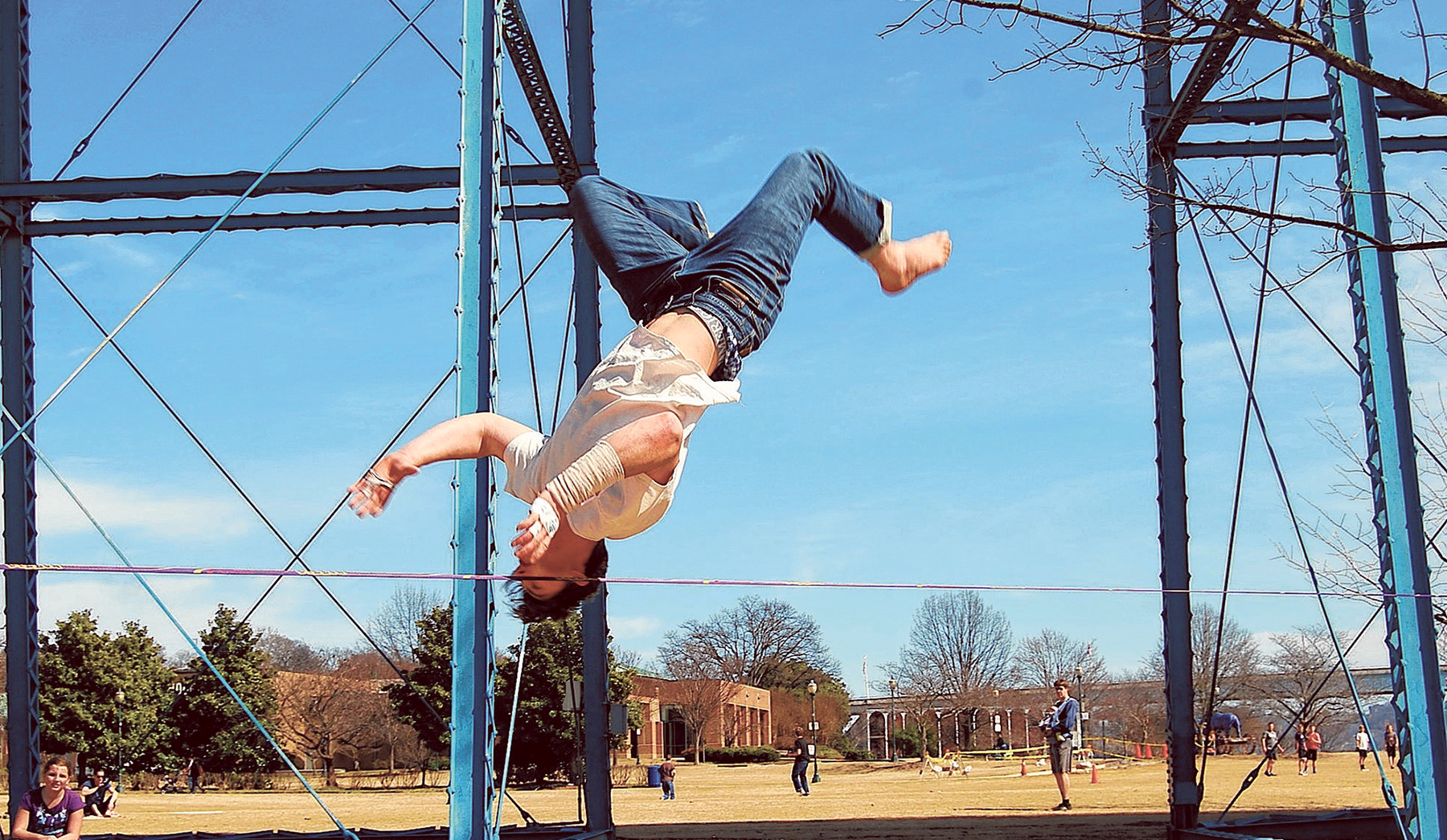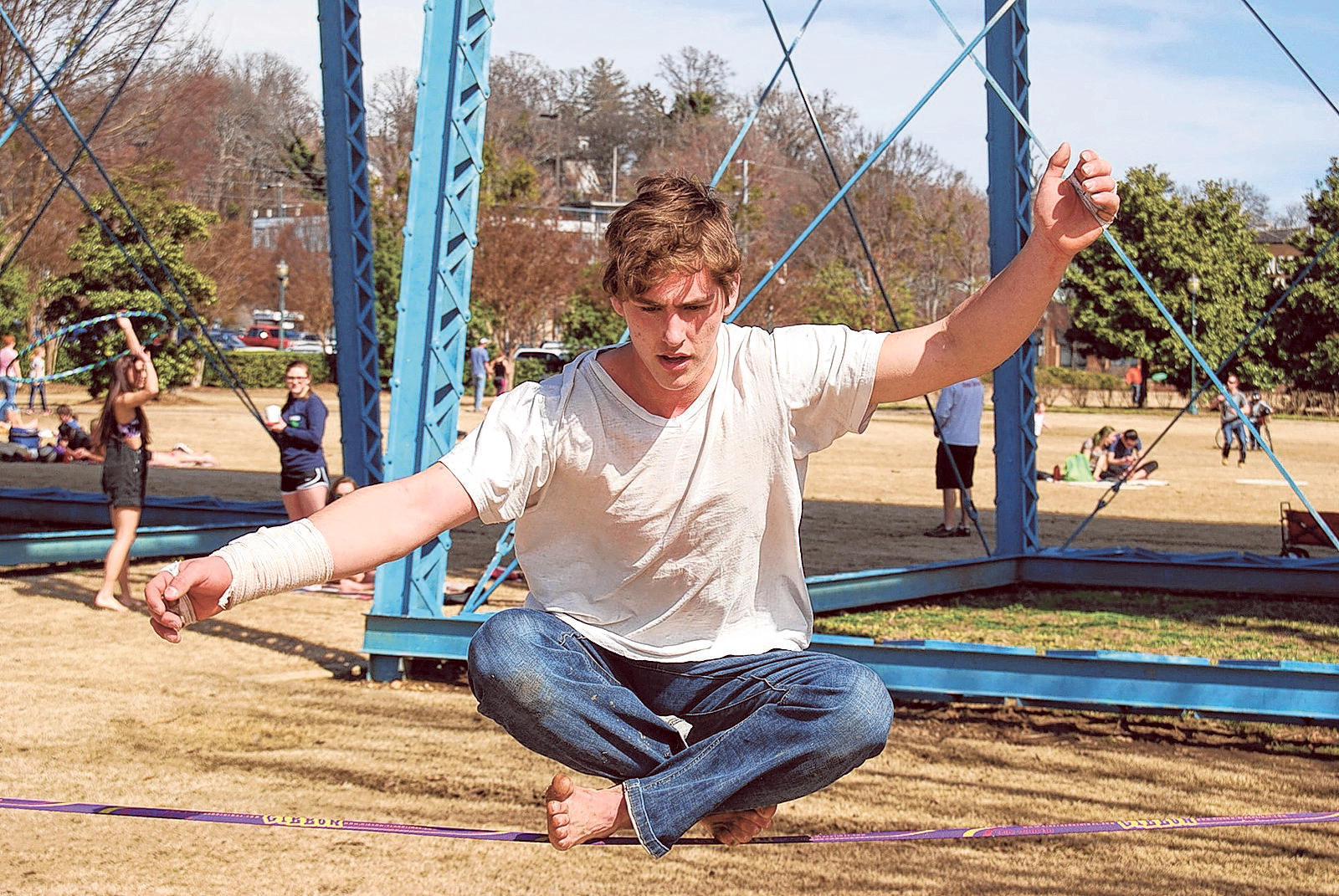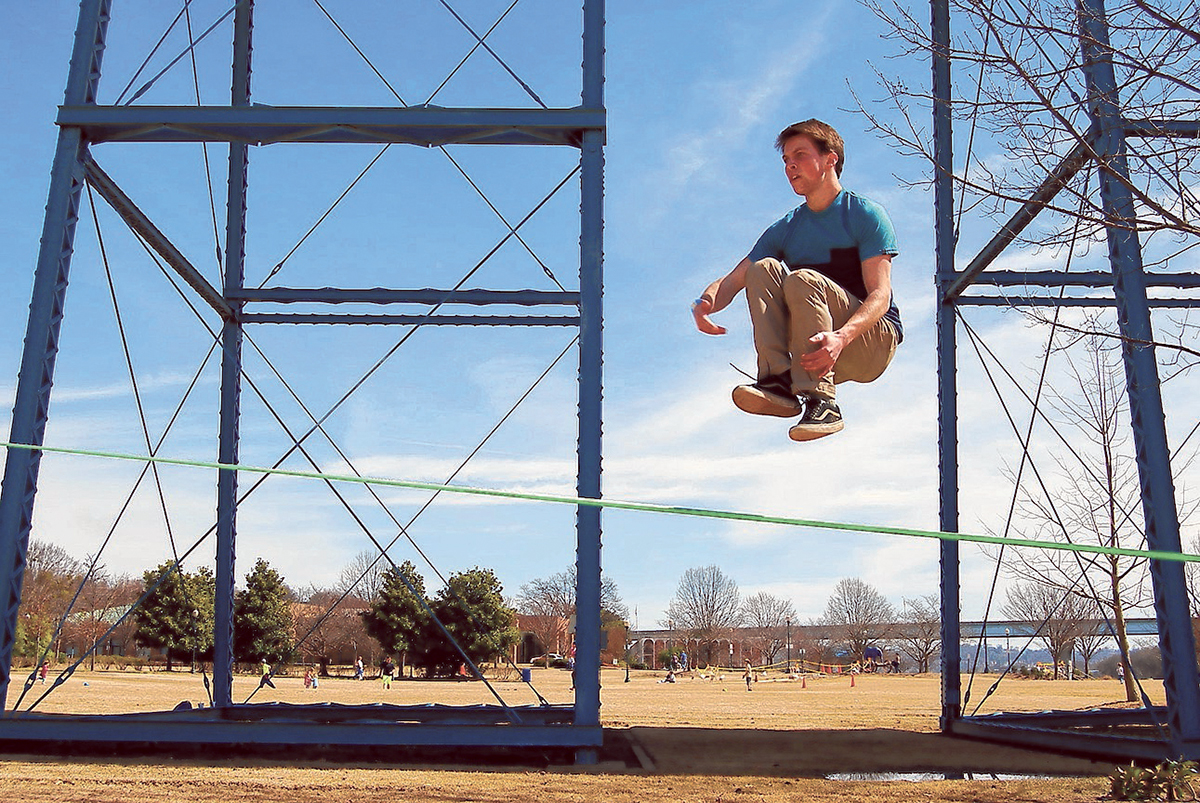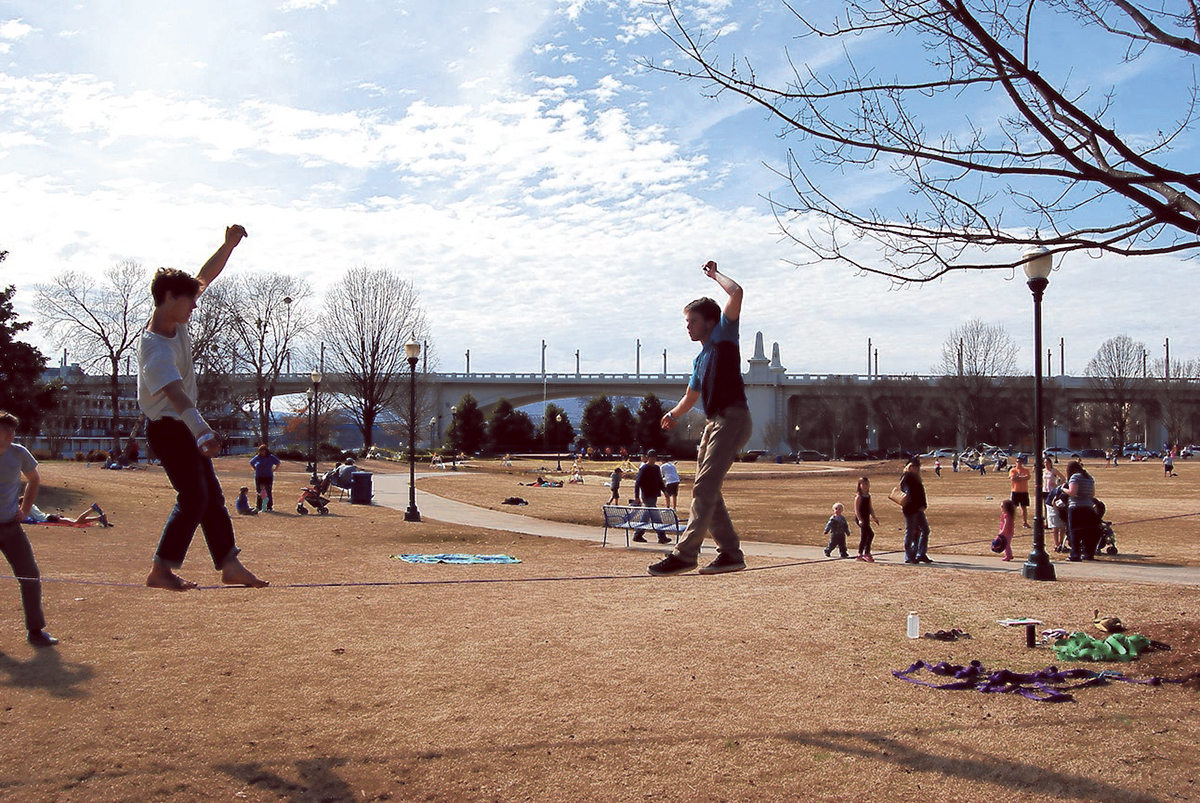When it comes to being slack, at least three local teenagers are mastering it.
Slacklining, that is.
McCallie juniors Connor Peach, Roy Tyson and Dan Harper love the sport of balance so much, they're wanting others to join in the fun. That's why the three energetic teens are seeking slacklining opportunities in area parks.
"About a year and a half ago, we started watching videos of people slacklining, and we knew we wanted to do it," says 16-year-old Roy.
"A slackline is a length of webbing suspended between two anchors. Anything that you do on this slackline is 'slacklining' -- most commonly, walking," says Connor, also 16.
But skilled slackliners take walking on the webbing to another level called "tricklining," which includes running, jumping, flipping, butt bouncing, handstands and several other moves.
Two-inch-thick webbing is typically used for slacklining close to the ground and known as low-lining, says 17-year-old Dan, while the 1-inch width is used for higher lines and, naturally, is called high-lining.
The teens low-line, using 1-inch webbing, which is about 2 feet to 6 feet off the ground, Connor says.
"High-lining involves a leash and you're usually around 40 feet off the ground or more," he says.
Roy says low-lining is safe and none of the three have been injured.
"It is awesome," adds Connor, who has already mastered such skills such as flipping and jumping.
Like other sports, slackline competitions are held all over the world but, to date, none have been held in the Chattanooga area, says Dan. Local interest in the sport and the ability to have slacklines in area parks probably would lead to local competitions and clinics, he adds.
In fact, the teens have already been contacted by a company that oversees competitive events and say the company spokesperson expressed interest in bringing a competition to Chattanooga if slacklining catches on in the area.
The McCallie students recently cleared their first hurdle by getting the City of Chattanooga's approval for slacklining in city parks, including Coolidge Park on the Tennessee River.
To get the OK, the teens gave city leaders information that included studies showing that slacklining is good for one's mental and physical health; it's safe; it's for people of all ages; and it's being done with great success in parks across the country.
"I've read studies showing that slacklining helps overall injury prevention. It increases your and also strengthens ACL recovery," Connor says.
Not long after they got the go-ahead from the city, the teens anchored their slacklines to trees in Coolidge Park, where they demonstrated the sport to park visitors.
"The whole park was watching us," says Roy. "Everyone, of all ages, had questions about the sport. They're all interested. The challenge of balancing is a lot of fun."
Bob Bires, dean of student life at McCallie, says the students' efforts to get slacklining approved in city parks is a great learning opportunity for the teens.
"Authentic leadership opportunities are so important for young people, and watching these boys work to turn their passion into a public service has been exciting," Bires says. "I'm grateful that our students live in a city where they have access to city officials willing to listen to their ideas."
The sport is illegal in Hamilton County parks, but the teens hope that changes in the near future. They hope to meet with local government officials in the Parks and Recreation Department.
For now, slacklines can legally be anchored to trees in Chattanooga city parks, as opposed to structures such as bridge supports and lampposts. Precautions must be taken, though anchoring to trees, Connor says.
"Trees are living, breathing beings and we should take whatever precautions necessary to protect them," Connor says.
To avoid using trees, he and his friends propose putting up posts in the parks for slacklines. They hope local artists will get involved by creating artistic, aesthetically-pleasing posts. Getting the poles in the parks is imperative for the sport to gain interest, Connor says.
Philip Grymes, executive director of Outdoor Chattanooga, supports the teens' plans to get slacklining rights in all area parks.
"Allowing slacklining in the park is a good thing. People love it," he says.
He's also in favor of erecting posts for the lines.
"We do need to create anchor points because some people will use trees that aren't big enough to support the weight. However, most everyone who has a slackline is intuitive of what size tree is appropriate. But in Coolidge Park, we don't have mature trees."
And the idea to enlist the help of artists to decorate the posts "is awesome," Grymes says.
Slacklining in area parks fits ideally with Outdoor Chattanooga's mission of making outdoor recreation an attractive, healthy and distinguishing lifestyle for Chattanooga's residents and visitor population, he says.
"It's a great exercise because, when you're trying to balance on that strap, you're moving so many muscles. And meanwhile, you're not thinking about the report you have to do or anything stressful because you're focusing on balancing.
"I think that more and more these days we need things to relieve stress and and slacklining offers that escape," Grymes says.
But you don't need official sanction or a big city park to enjoy slacklining, he says.
"Anyone can put a slackline in their back yard at a really low cost. All you need is to create the anchor points and the straps," Grymes says. "It's also a social thing. When one is set up, everyone -- kids and adults -- wants to do it."
The McCallie students have bigger ambitions than just getting slacklining approved for local parks. They're looking for an urban greenspace to establish a park dedicated exclusively to slacklining.
"We need a community space for our (slacklining) community, and outlawing slacklining is not a solution," Connor says. "I want a place where the people interested enough can try it out on a line. I want them to have the opportunity to really get into it as well.
"This sort of thing has been done in a number of other cities," he says, including Charleston, S.C., and Murphy, N.C.
The teens have spoken with Edward Yates, who walked a slackline between the peaks of the Tennessee Aquarium peaks last year. They hope he will join their efforts.
"I have the utmost confidence that we will succeed, and I don't see a reason why someone would be unhappy about that."
Contact Karen Nazor Hill in khill@timesfree press.com or 423-757-6396.
